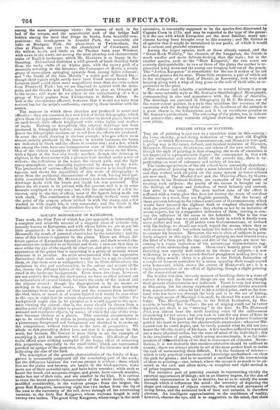GOULD'S MONOGRAPH OF KANGAROOS.
THIS work, the First Part of which has just appeared, is interesting as a complete and scientific account of a singular class of animals only recently known to Europeans, and with whose habits we are as yet but little acquainted : it is also remarkable for being the first work on Mammalia the result of personal observation by the naturalist ; and the value of this feature is apparent in the plates. There are fifteen dif- ferent species of Kangaroos figured in this part ; and their several cha- racteristics are indicated in so distinct and lively a manner, that they at once strike the eye of the superficial observer, and give a variety to the appearance of the plates that is surprising in a group of animals whose structure is so peculiar. An artist unacquainted with the expressive distinctions that mark each species would have been apt to confound them, or slur them over as unimportant ; but in these delineations the variations in size and conformation, in the colour and texture of the fur, denote the different habits of the animals, whose locality is indi- cated in the landscape backgrounds. Even these drawings, however, are not entirely free from the discrepancy we have so often pointed out in delineations of natural history, between the scale of the animal and the objects around ; though the disproportion is by no means so striking as in many other works. This defect arises from picturing the landscape from one point of view and the creature from another : the bird, beast, or insect, is of course figured as it would be seen close to the eye, in order that its minute characteristics may be visible : the background ought also to be pictured as it wculd appear to the spec- tator viewing the animal—that is, the scene should be drawn from a similar point of sight, in order to preserve the relative proportions of the animate and inanimate objects, by means of which the size of the crea- ture becomes obvious at a glance. This essential circumstance is apt to be overlooked by artists in portraying men as well as brutes : a picturesque foreground and background are sketched in to make up the composition, without reference to the laws of perspective. We allude to this prevailing defect here, not that it is prominent in this work, but because Mr. Goma) is most likely to set the example of rectifying it, and his authority will guide others. His Birds of Aus- tralia afford some striking examples of the happy effect of observing this proportion, especially in the small birds ; which are represented perched on sprays of the gum-tree, the scale of the blossoms and stalk indicating the size of the bird.
The description of the generic characteristics of the family of Kan- garoos is necessarily postponed till the concluding part of the work ; but the difference between the various groups is evident : those which live on the plains and browse, are larger in the hind-quarters, make more use of their powerful tails, and have hairy muzzles ; while such as haunt the brush and mountain-ridges, and graze, have smooth muzzles, snake less use of their tails, and are smaller in the hips. It is curious to trace the broad generic characteristics of the whole family, though modified considerably, in the various groups : from the largest,. the great Red Kangaroo, measuring eight feet two inches from the tip of the nose to the extremity of the tail, down through all the intervening varieties, to the little Rat Kangaroo, whose extreme length is only twenty-two inches. The great Gray Kangaroo, whose range is the most
extensive, is reasonably supposed to be the species first discovered by Captain COOK in 1770, and may be regarded as the type of the genus: it is the one with which Europeans are the most familiar, many spe- cimens having been brought over to this country ; and Mr. Goma is of opinion that it might be naturalized in our parks, of which it would be a curious and graceful ornament.
Among the larger species, such as those already named, and the "Great Rock Wallaby," the chamois of the kangaroos, the female is mach smaller and more delicate-looking than the male ; but in the smaller species, such as the "Hare Kangaroo," the two sexes are scarcely distinguishable: in two or three of the plates the mother is re- presented lying down and the young one hanging half out of the pouch. The "Jerboa Kangaroo" is remarkable for the use it makes of its tail to collect grasses for its nest. These lictle creatures, a pair of which are in the menagerie of the Earl of DERBY, at Knowsley, look very droll hopping along with a wisp of long grass in the coil of their tails, as re- presented in the plate. This curious and valuable contribution to natural history is got up in the same splendid style as Mr. GOULD'S Ornithological Monographs, corresponding in size and appearance with the Birds of Australia. The drawings are executed in lithography by H. C. RICHTER, son of the water-colour painter, in a style that combines the accuracy of the naturalist with the feeling of the artist : the liveliness of the animals is a great charm in the delineations, and it is an excellence peculiar to Mr. GOULD'S publications. The colouring of the plates, too, is delicate and painter-like ; they resemble original drawings rather than com- mon prints.


























 Previous page
Previous page